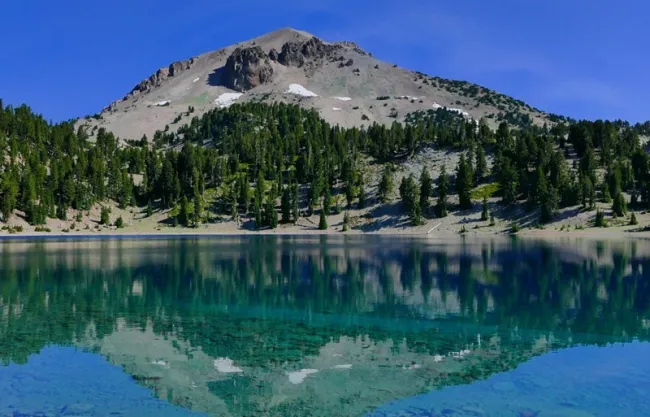
Lassen Volcanic National Park, located in Northern California, is a hidden gem in the U.S. National Park system. Known for its geothermal features, pristine mountain landscapes, and diverse ecosystems, this park offers a quieter and less crowded experience than some of its more famous counterparts. Lassen Peak, the largest plug dome volcano in the world, is the park's centerpiece and a must-see for visitors.
History of the Park
Lassen Volcanic National Park was established on August 9, 1916, following a series of eruptions from Lassen Peak between 1914 and 1921. These eruptions captured national attention and demonstrated the power of volcanic activity in the United States. The park preserves not only the remnants of these eruptions but also an array of geothermal features, such as fumaroles, hot springs, and boiling mud pots. Native American tribes, including the Atsugewi, Maidu, and Yana people, have long histories in the region, and the park holds cultural significance for them as well.
Main Features
Lassen Volcanic National Park is known for its unique volcanic landscapes, which include:
- Lassen Peak: A striking volcanic mountain that dominates the park’s skyline.
- Bumpass Hell: A geothermal area with boiling springs and steaming vents, reminiscent of Yellowstone.
- Sulphur Works: Another active hydrothermal area, accessible by car.
- Manzanita Lake: A peaceful spot for kayaking, fishing, and viewing Lassen Peak's reflection.
- Cinder Cone: A scenic volcanic cone with views over colorful lava beds and surrounding forest.
Types of Trails
Lassen Volcanic National Park offers a variety of trails for all experience levels:
- Easy Trails: The Manzanita Lake Loop (1.8 miles) is a gentle walk around a picturesque lake, ideal for families and those seeking a leisurely stroll.
- Moderate Trails: The Bumpass Hell Trail (3 miles round trip) takes hikers through geothermal areas, offering an up-close look at bubbling springs and steaming vents.
- Challenging Trails: The Lassen Peak Trail (5 miles round trip) is a steep and strenuous climb but rewards hikers with panoramic views from the summit.
Crowd Expectations and Annual Visitors
Lassen Volcanic National Park is one of the quieter national parks, attracting around 500,000 visitors annually. Crowds are generally light, even during the peak summer months. Weekends in July and August tend to be the busiest, but the park rarely feels overcrowded. Visitors looking for solitude will find it easier here compared to parks like Yosemite or Yellowstone.
Accessibility for Seniors
The park offers several accommodations for senior visitors. Many of the scenic viewpoints, such as Sulphur Works, are accessible by car, allowing seniors to enjoy the beauty of the park without extensive hiking. The park also provides benches at strategic spots along some of the shorter trails for rest.
Accessibility for Wheelchairs
Lassen Volcanic National Park has made efforts to improve accessibility for wheelchair users. The Sulphur Works area is one of the most accessible geothermal features, with a paved path leading to the site. The visitor centers are also wheelchair-friendly, and some campgrounds have accessible sites. However, due to the rugged terrain, many of the trails are not accessible, so visitors should plan accordingly.
Park Amenities
Lassen Volcanic National Park provides several visitor amenities, including:
- Loomis Museum: Located near Manzanita Lake, this museum offers exhibits on the park’s volcanic history and geology.
- Kohm Yah-mah-nee Visitor Center: The main visitor center, open year-round, offers educational exhibits, a café, and a gift shop.
- Picnic Areas: Multiple picnic spots are available throughout the park, including at Manzanita Lake and Summit Lake.
Camping Facilities
The park offers eight campgrounds, with both reservable and first-come, first-served options. Popular campgrounds include:
- Manzanita Lake Campground: Offers 179 sites, with some accommodating RVs up to 40 feet.
- Summit Lake Campground: Divided into North and South sections, this campground provides a more remote experience with access to hiking trails.
- Butte Lake Campground: A quieter option, ideal for visitors who want to explore the Cinder Cone area.
Access to Lodging
While there are no lodges within Lassen Volcanic National Park itself, several nearby towns offer lodging options. The town of Chester, located about 30 minutes from the park's southwest entrance, has hotels, motels, and vacation rentals. For a more rustic experience, cabins are available at Manzanita Lake.
Pet-Friendliness
Pets are allowed in Lassen Volcanic National Park but with some restrictions. Pets must be on a leash at all times and are allowed only in developed areas, such as campgrounds, parking lots, and paved roads. Pets are not permitted on trails or in the backcountry, which limits their access in the park.
Best Months to Visit
The best time to visit Lassen Volcanic National Park is from late June to early October when the park is fully accessible. Snow can linger in the higher elevations well into the summer, and some areas may remain closed until July. Fall, from September to early October, offers cooler temperatures and fewer crowds, making it an ideal time for hiking and exploring.
Conclusion
Lassen Volcanic National Park is a captivating destination for those seeking volcanic landscapes, geothermal wonders, and outdoor adventures away from the crowds. Whether you're hiking to Lassen Peak, relaxing by Manzanita Lake, or exploring the bubbling hot springs of Bumpass Hell, Lassen offers a unique and rewarding experience for nature enthusiasts. With thoughtful accessibility options, comfortable camping facilities, and a range of activities, it’s a park that caters to adventurers of all ages and abilities.



